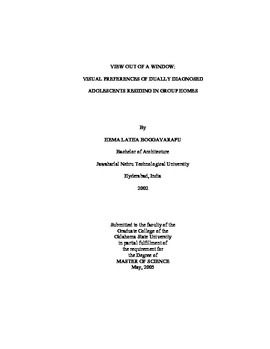| dc.contributor.advisor | Drab, Theodore | |
| dc.contributor.author | Boggavarapu, Hema Latha | |
| dc.date.accessioned | 2014-04-15T20:39:50Z | |
| dc.date.available | 2014-04-15T20:39:50Z | |
| dc.date.issued | 2005-05-01 | |
| dc.identifier.uri | https://hdl.handle.net/11244/8963 | |
| dc.description.abstract | The purpose of this study is to determine visual preferences of dually diagnosed adolescents residing in group homes. A purposive sample of 37 adolescents of ages 11-17 years residing in group homes in Oklahoma and Tennessee was used in this study. Mailed questionnaire with mostly closed ended questions was used as the instrument for this study. Results of this study show that the dually diagnosed adolescents prefer a landscape dominated by natural vegetation such as trees and plants over man-made structures and a combination of both natural vegetation and man-made structures. The preferred natural vegetation consists of fruit bearing trees and flowering plants. Flowing water was preferred more than calm water. Between the water bodies, small water bodies such as pools and fountains were preferred more than large water bodies such as oceans and seas. Among the man-made structures, though multi storey buildings were more preferred than single storey buildings, the participants still preferred to look at other houses. Equal quantities of natural vegetation and man-made structures were also more preferred than other combinations. In terms of view appearance, though participants preferred animated scenes more than unanimated scenes, there wasn't significant difference between the two. It could be inferred that the type of scene (animated/unanimated) doesn't matter as long as the setting/scene engages the viewer's mind (compatibility from Attention Restoration Theory). The results of this study are important for interior designers, architects, planners, and environmental psychologists to understand the importance of these elements and incorporate them in their future designs. By providing residents' choice of visually preferred environment in the outdoors can influence their emotions, which in turn may have an effect on their physical and mental health. | |
| dc.format | application/pdf | |
| dc.language | en_US | |
| dc.publisher | Oklahoma State University | |
| dc.rights | Copyright is held by the author who has granted the Oklahoma State University Library the non-exclusive right to share this material in its institutional repository. Contact Digital Library Services at lib-dls@okstate.edu or 405-744-9161 for the permission policy on the use, reproduction or distribution of this material. | |
| dc.title | View out of a Window: Visual Preferences of Dually Diagnosed Adolescents Residing in Group Homes | |
| dc.type | text | |
| dc.contributor.committeeMember | Bormann, Carol | |
| dc.contributor.committeeMember | Vogel, Lisa | |
| osu.filename | Boggavarapu_okstate_0664M_1357.pdf | |
| osu.college | Human Environmental Sciences | |
| osu.accesstype | Open Access | |
| dc.description.department | Department of Design, Housing and Merchandising | |
| dc.type.genre | Thesis | |
| dc.subject.keywords | mental retardation | |
| dc.subject.keywords | visual preferences | |
